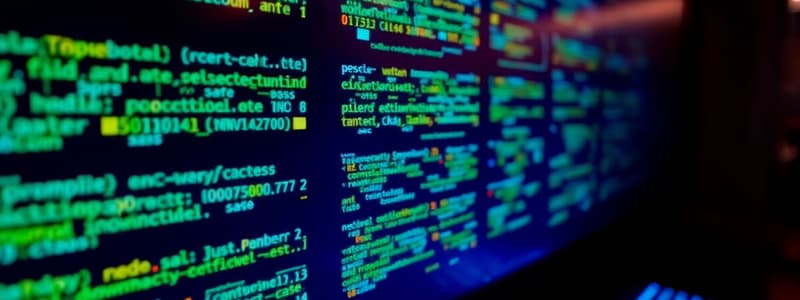Podcast
Questions and Answers
Which of the following best describes the function of protocols in computer networks?
Which of the following best describes the function of protocols in computer networks?
- Providing additional services such as printing and faxing.
- Managing the physical connections between computers.
- Securing the network from external threats.
- Defining the rules for communication between devices. (correct)
Which component is NOT typically considered a basic hardware component of a network?
Which component is NOT typically considered a basic hardware component of a network?
- Operating System (correct)
- Server
- Router
- Network Interface Card (NIC)
Which of the following network components operates at the intersection of hardware and software by converting digital signals to analog signals for transmission over telephone lines?
Which of the following network components operates at the intersection of hardware and software by converting digital signals to analog signals for transmission over telephone lines?
- Switch
- Repeater
- Modem (correct)
- Hub
In the context of network security, what is the primary purpose of security software?
In the context of network security, what is the primary purpose of security software?
Which type of network topology offers high redundancy by connecting each device to every other device in the network?
Which type of network topology offers high redundancy by connecting each device to every other device in the network?
Which benefit is LEAST likely to be associated with computer networks?
Which benefit is LEAST likely to be associated with computer networks?
What is a key characteristic of a Metropolitan Area Network (MAN) compared to a Local Area Network (LAN)?
What is a key characteristic of a Metropolitan Area Network (MAN) compared to a Local Area Network (LAN)?
Which of the following is a disadvantage of using copper cables compared to fiber optic cables for network connections?
Which of the following is a disadvantage of using copper cables compared to fiber optic cables for network connections?
Which of the following best describes the function of a network switch?
Which of the following best describes the function of a network switch?
In network troubleshooting, why might you test the connection to a router using the command prompt?
In network troubleshooting, why might you test the connection to a router using the command prompt?
What is a key difference between peer-to-peer and client/server networks?
What is a key difference between peer-to-peer and client/server networks?
Which type of network cable is MOST susceptible to eavesdropping?
Which type of network cable is MOST susceptible to eavesdropping?
What is the function of a repeater in a network?
What is the function of a repeater in a network?
Which action is LEAST likely to help when troubleshooting a network connectivity issue?
Which action is LEAST likely to help when troubleshooting a network connectivity issue?
What is the primary purpose of a 'logic bomb' in the context of network security threats?
What is the primary purpose of a 'logic bomb' in the context of network security threats?
Flashcards
What is a Network?
What is a Network?
A group of interconnected computers, peripherals, and software that enables the exchange of information.
What are Computer Networks?
What are Computer Networks?
Interconnected computers that share resources, data, and applications under specific protocols.
What are Communication Channels?
What are Communication Channels?
Physical and logical pathways for data transmission, like cables or wireless signals.
What is Resource Sharing?
What is Resource Sharing?
Signup and view all the flashcards
What are Operating Systems?
What are Operating Systems?
Signup and view all the flashcards
What are Protocols?
What are Protocols?
Signup and view all the flashcards
What are Wired Media?
What are Wired Media?
Signup and view all the flashcards
What are Wireless Media?
What are Wireless Media?
Signup and view all the flashcards
What is LAN?
What is LAN?
Signup and view all the flashcards
What is MAN?
What is MAN?
Signup and view all the flashcards
What is WAN?
What is WAN?
Signup and view all the flashcards
What is Network Security?
What is Network Security?
Signup and view all the flashcards
What is Malware?
What is Malware?
Signup and view all the flashcards
What are Keyloggers?
What are Keyloggers?
Signup and view all the flashcards
What isPhishing?
What isPhishing?
Signup and view all the flashcards
Study Notes
- The presentation generally covers security and networking concepts for second-year computer science students in the academic year 2024-2025
What are Networks?
- Networks consist of hardware components like computers and their peripherals
- Networks also include software components like operating systems
- Protocols ensure the proper flow of information between these computers.
Computer Networks
- Computer networks are interconnected computers using communication lines for data exchange, resource sharing, and application access
- These networks are managed by specialized software and follow specific agreements or protocols
- A network consists of two or more computers, linked via wired or wireless mediums
- Communication lines provide the connection for data transfer
- Connection describes the process of sending and receiving data
- Shared resources include devices that offer services like printing and faxing
Computer Network Systems
- A computer network system involves connecting two or more computers for data exchange and information sharing
- Peripherals such as printers and scanners can be directly connected using cables
- Cables include coaxial cables, twisted pair cables, or fiber optic cables
- Each computer requires a Network Interface Card (NIC)
- Data can be transmitted via telephone lines if computers are far apart, although this is slower
- Modems or fax cards may be required to convert digital signals to analog signals and vice versa for telephone line communication
Benefits of Computer Networks
- Information sharing is conducted quickly and easily between networked devices
- Shared resources and peripheral devices can be shared within a network
- Centralized management simplifies the administration of shared workspaces
- Large volumes of information can be stored in databases that are indexed and easily accessible
- Immediate communication is facilitated through email and messaging
- Reduced costs stem from the ability to share resources
- Exchanging files is made easy for network users
- Internet access can be provided to users
- E-learning platforms offer simple access to educational resources
- Online communication platforms streamline the process of communication for individuals
- Information is available from diverse sources across different domains
Basic Components of a Network
- Hardware Components: Physical elements of a network
- Desktop and laptop computers serve as workstations for various tasks and application management
- A server is a central device offering network resources and services to other devices
- Routers connect multiple networks and manage data traffic using IP addresses
- Switches connect devices within a local network for efficient data transfer
- Access points expand wireless signal range for devices within the network
- Hubs connect network devices and transmit data to all ports
- Bridges connect two local networks and filter traffic based on MAC addresses
- Repeaters amplify and retransmit network signals to improve coverage over longer distances
- NICs provide wired or wireless connectivity, each with a unique MAC address
- Modems allow internet connection by converting analog signals to digital signals and vice versa
Software Components
- Operating Systems manage network operations and provide user interfaces
- Protocols define the communication rules between devices
- Security Software protects the network from threats and attacks
- Network Software includes tools for network admin, security, data administration, and user permissions
- Network admin tools organize operations and allocate resources for users
- Security establishes network confidentiality and protection
- Data admin organizes databases, prioritizes the use of supplementary devices
- User Access specifies permissions for each user and monitors network operations
- Windows NT and Novell, are examples of programs
Media
- Wired Media includes twisted pair cables that are used in Ethernet networks
- Coaxial cables are usually used in TV networks
- Fiber optic cables are used for extremely high transfer speeds, and use light to transfer data
- Wireless Media uses electromagnetic waves to transmit data
- Wi-Fi, Bluetooth, and infrared tech are all examples of wireless media
Wired vs Wireless Media
- Wired connections transfer data at a limited speed compared to fiber optic cables
- Wireless connections have very high transfer speeds, and can transfer over long distances
- Wired connections are inexpensive and simple to set up
- Wireless connections are specialized and need maintenance
- Wired connections are less safe and prone to eavesdropping and data theft
- Wireless connections have high safety
- Wired is well suited for small local networks,
- Wireless is well suited for networks that work over long distances
Network Topology
- Physical, and logical arrangement of network nodes and connection
- Bus networks are low cost and easy to setup but are less effective with lots of node
- Star networks are are easy to troubleshoot and setup but the performance depends on the performance of the central devices
- Ring networks transmits data well but if one devices fails it compromises the whole network
- Mesh Networks provides coverage, and has high reliability when set up .
- Hybrid networks are also a thing that combines advantages for networks
Network Service Types
- Peer-to-Peer Network pros are Cost-effective and Easy to set up
- Peer-to-Peer Network cons are Less secure with Difficult data admin and has Lesser performance
- Client Servers have High security but there is Central management of resources, they also have Enhanced performance
- Client Servers need High setup and maintenance costs but are reliable with a single point of failure
Network Scope
- Local Area Network (LAN) is within a limited area like a house
- Metropolitan Area Network (MAN) spans across greater geographical areas, such as a city
Network Security Basics
- It employs protocols, configurations, and practices to maintain the trustworthiness, confidentiality, and accessibility of networks and data
- Security measures are key for defending a network and its data
- Firewalls, encryption, intrusion detection, access control, authentication, and security updates are some components for network security
- A main objective of security, is to defend against cyber threats
- Common cyber threats include; viruses, malware, breaches, and coordinated attacks
Network Security Threats
- Includes any deliberate actions or attempts to leverage network vulnerabilities to jeopardise and steal data and disrupt services
- Malware is a malicious software designed to damage targeted networks
- Keyloggers record every keystroke to steal login details or personal information
- Trojan horses are programs that deceive users by concealing malicious plans in seemingly innocent software
- Ransomware locks access to devices or apps and ask a compensation
- Adware are popup advertisement generating software which consumes the system resources
- Spyware secretly collects sensitive data without the user knowing
- Logic Bombs; sets to be activated at certain date
- Phishing; tricks users for the purpose of downloading malwares
Network Troubleshooting
- Identify and fix problems that can affect the network
- Connection can be on the internet
- The steps to find the network are
- Double check all the connected devices
- Double check the cables
- Double check routers
- Restart devices
- Check internet
How to check the internet
- Find Command Prompt in windows
- enter "ping 8.8.8.8"
- If you get back a response then you have connection to internet
- Run "ping" on another computer
- Make you sure have you have enabled the right IP
Some more tools for Network Troubleshooting
- Makesure Router is working
- Check Router connection
- Check Antivirus
- Check Internet Speed
- Use third party network troubleshooting program
Studying That Suits You
Use AI to generate personalized quizzes and flashcards to suit your learning preferences.




